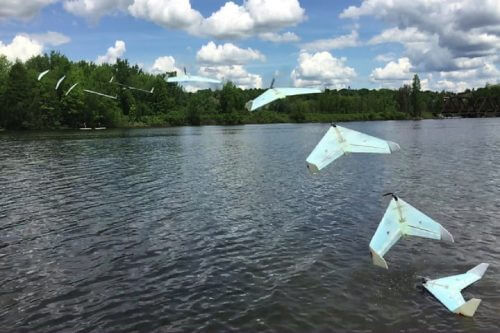Tiny vessels capable of operating in both air and water inspired by seabirds and marine animals

By: Amir Weiss
In nature there are animals that know how to adapt their function to different environmental conditions, and are able to move efficiently between distinct environments. For example, the giant squid launches itself from the water into the air using a water jet; The salamander is able to walk on land and swim in water. Inspired by nature, products are currently being developed that are required to operate in different environmental conditions, and to adapt to transitions between environments, for example, transitions between air and water, land to air, or water to land.
A water environment and an air environment are very different from each other; The characteristics that characterize each environment, for example, density, temperature, pressure, etc., pose a challenge to the following to develop a tool capable of moving efficiently between air and water and vice versa, and to function well in these two environments.
Researchers from the University of Sherbrooke (Sherbrooke) in Canada have developed a fixed-wing drone (SUWAVE) Sherbrooke University Water-Air Vehicle, which takes off from lakes and lands in them in a process designed inspired by the mallard duck. A fixed-wing aircraft is effective for cruising and staying in the air for a long time, but it usually requires a supporting infrastructure for takeoff and landing. In contrast, the SUWAVE drone was designed to make a controlled "rape landing" on a water surface. The drone is charged with solar energy when it floats on the water, and takes off from the surface of the water using a unique mechanical mechanism: the central part of the drone's body contains a shaft with a battery on one side and a propeller on the other. Tilting the axis causes the body of the drone to tilt and take the propeller out of the water. After that, the drone's engine is turned on, and the axis aligns with the drone in the direction of flight.
The strength of the drone's structure and its small dimensions - its weight is 580 grams - allow it to withstand the aggressive but controlled landing. The drone was also designed to be water resistant and buoyant.
Another drone, AquaMAV - Aquatic Micro Air Vehicle, was developed by a team of researchers at Imperial College of London. It is an aircraft that dives into a water source inspired by the diving abilities of seabirds, propels itself into action underwater, and then returns to flying in the air. It will be possible to use such a tool in the future to launch a submarine and return to it at the end of the mission.
The AquaMAV is also a small vessel: it weighs about 200 grams and its wingspan is 60 cm. Therefore, he is able to dive into the water without being damaged by the force of the impact on the water surface. When diving, the wings fold back at 90 degrees, similar to how seabirds dive into the water.
https://www.youtube.com/watch?v=LByD8Hx9s_w
In order to develop the drone's capabilities to take off from the water into the air, the team studied the Oceanic Flying Squid, which launches itself into the air by injecting a jet of water backwards. Inspired by the squid, a pressure tank containing CO was installed in this drone2 used to launch the vessel out of the water.
Another team of a robotics research laboratory at the Johns Hopkins Applied Physics Laboratory, developed a tiny fixed-wing UAAV - Unmanned Aerial-Aquatic Vehicle, powered by a single propulsion system that can be used both in the air and in the water. This vessel moves from the water to the air inspired by another aquatic creature - a flying fish - which accelerates itself in the water, then leaps into the air and uses its long fins as wings for flight.
These tools are intended for conducting marine research by photographing or collecting samples from the water and processing them.
